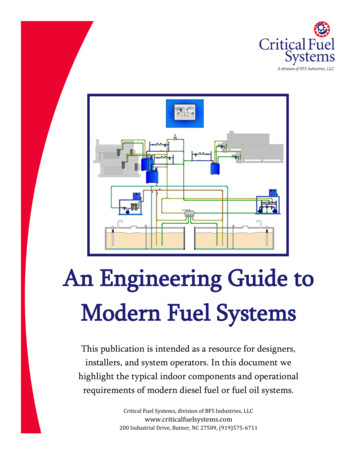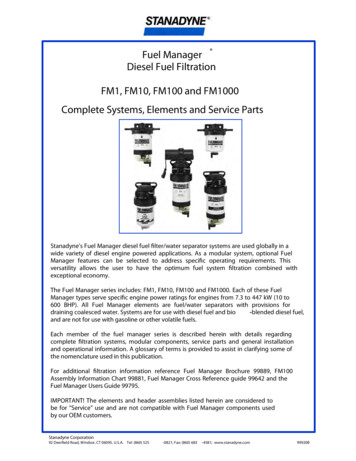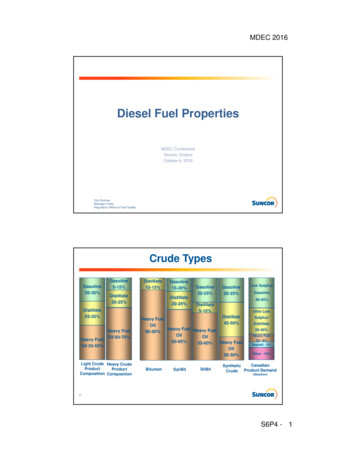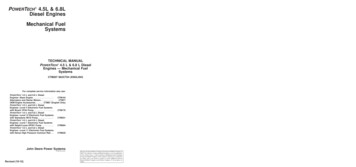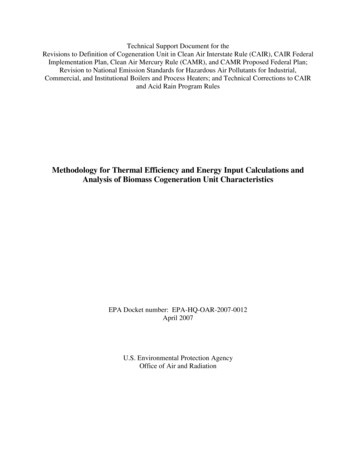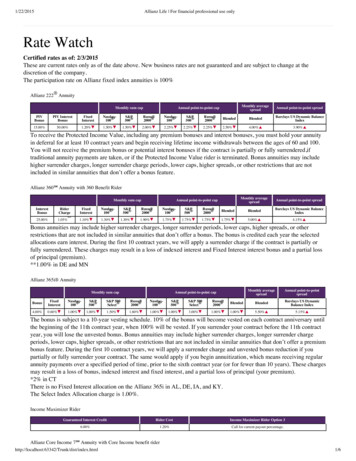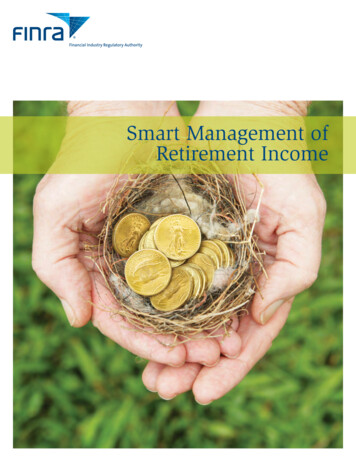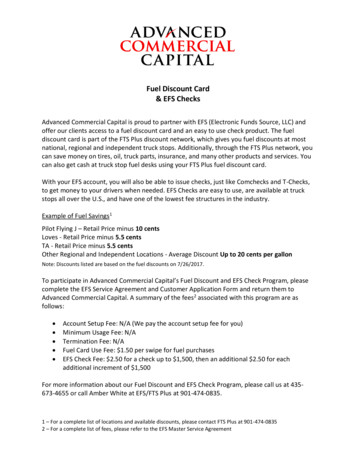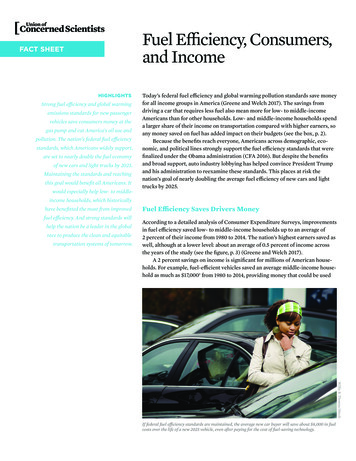
Transcription
Fuel Efficiency, Consumers,and IncomeFACT SHEETHIGHLIGHTSStrong fuel efficiency and global warmingemissions standards for new passengervehicles save consumers money at thegas pump and cut America’s oil use andpollution. The nation’s federal fuel efficiencystandards, which Americans widely support,are set to nearly double the fuel economyof new cars and light trucks by 2025.Maintaining the standards and reachingthis goal would benefit all Americans. Itwould especially help low- to middle-Today’s federal fuel efficiency and global warming pollution standards save moneyfor all income groups in America (Greene and Welch 2017). The savings fromdriving a car that requires less fuel also mean more for low- to middle-incomeAmericans than for other households. Low- and middle-income households spenda larger share of their income on transportation compared with higher earners, soany money saved on fuel has added impact on their budgets (see the box, p. 2).Because the benefits reach everyone, Americans across demographic, economic, and political lines strongly support the fuel efficiency standards that werefinalized under the Obama administration (CFA 2016). But despite the benefitsand broad support, auto industry lobbying has helped convince President Trumpand his administration to reexamine these standards. This places at risk thenation’s goal of nearly doubling the average fuel efficiency of new cars and lighttrucks by 2025.income households, which historicallyhave benefitted the most from improvedfuel efficiency. And strong standards willhelp the nation be a leader in the globalrace to produce the clean and equitabletransportation systems of tomorrow.Fuel Efficiency Saves Drivers MoneyAccording to a detailed analysis of Consumer Expenditure Surveys, improvementsin fuel efficiency saved low- to middle-income households up to an average of2 percent of their income from 1980 to 2014. The nation’s highest earners saved aswell, although at a lower level: about an average of 0.5 percent of income acrossthe years of the study (see the figure, p. 3) (Greene and Welch 2017).A 2 percent savings on income is significant for millions of American households. For example, fuel-efficient vehicles saved an average middle-income household as much as 17,0001 from 1980 to 2014, providing money that could be usedWillie B. Thomas/iStockIf federal fuel efficiency standards are maintained, the average new car buyer will save about 6,000 in fuelcosts over the life of a new 2025 vehicle, even after paying for the cost of fuel-saving technology.
for other essentials, from food and clothing to education,health care, and family savings (Greene and Welch 2017).The current fuel efficiency standards, if maintained, areforecast to once again provide net savings to all Americandrivers, including low- and middle-income households. The2017–2025 federal fuel efficiency and global warming pollution standards are on track to save the average new car buyerabout 6,000 over the life of a new 2025 vehicle, even afterpaying for the cost of technology to improve fuel efficiency(UCS 2016).2 Collectively, improved fuel efficiency is forecastto save Americans a total of about 50 billion by 2030, moneythey can spend locally instead of profiting multinational oilcompanies (UCS 2016).The Impact of Fuel Efficiency on RuralDriversRural Americans tend to travel farther to access jobs andservices than do city dwellers, making them typically moredependent on personal vehicles. At the same time, lowerpopulation densities in rural areas make it more challenging to deploy many transportation options that are relativelycommon in cities, such as public transportation or bicyclinginfrastructure. In a survey by the American Public Transportation Association, only 11 percent of rural respondents hadpublic transportation available to their homes, compared with83 percent in central cities (APTA n.d.).Relative to urban households, rural households tend toown more vehicles and, as a result, spend more of their totalincome on vehicle purchases, gasoline and motor oil, insurance, and vehicle maintenance (BLS 2016). Providing bothrural and urban low-income communities with better transitoptions and with vehicles that cost less to fuel can help maketransportation more affordable and its costs more predictable,protecting drivers from oil price swings.Fuel Efficiency Standards Keep VehiclesAffordableAutomakers claim that fuel efficiency standards make vehicles more expensive and less affordable, especially forlow-income consumers (AAM 2016). Indeed, increasing fuelefficiency does come at a modest cost, but the rise in the average transaction price of a new vehicle can be attributed largely to automakers’ increased sales focus on luxury SUVs andexpensive pickup trucks, both of which usually yield higherprofit margins than do smaller, more fuel-efficient vehicles(Baum and Luria 2016).2union of concerned scientistsThe Impact of VehicleOwnership Costs onLow-Income HouseholdsTransportation represents the second largest expense formany Americans (BLS 2015). The average middle-incomehousehold devotes almost 20 percent of its income to transportation (Schanzenbach et al. n.d.). Over one-quarter of thatgoes to gasoline and motor oil (BTS 2016). For low-incomehouseholds, transportation consumes about 30 percent oftotal income (Haas et al. 2006). These households typicallyspend more on fuel than on vehicle purchases, so anymoney saved on fuel has added impact on their budgets(Greene and Welch 2017).As sprawl has worsened and access to affordablehousing in cities or near transit hubs has decreased, affordable and efficient transportation options have become lesslikely to serve low-income communities. As a result, manylow-income households have placed a greater reliance onpersonal vehicles as their primary mode of transport.The automakers’ focus on less-efficient vehicles hashelped widen the price gap between the cheapest and mostexpensive vehicles on the market (Comings and Allison 2017).Yet the top-selling affordable new vehicles in 2015 actuallycost almost the same as those marketed in 2005. For example,the 2015 Chevrolet Cruze L Manual sold for 16,170; in 2005,a new Honda Civic DX sold for 16,177 in 2015 dollars. In contrast, the most expensive vehicles of 2005 cost 40 percentmore in 2015 after adjusting for inflation.In other words, the average transaction price of a newvehicle has risen due in part to the rise in the price of luxuryvehicles. At the same time, the cost of the most affordable vehicles has remained effectively constant even though today’svehicles are more efficient and cheaper to drive.The rise in the averagetransaction price of a newvehicle can be attributedlargely to automakers’increased sales focuson luxury SUVs andexpensive pickup trucks.
Consumers Want Fuel EfficiencyGiven the burden that transportation places on many household budgets, as well as continuing fluctuations in gasolineprices, it should come as no surprise that consumers supportstrong fuel efficiency standards. The Consumer Federationof America found that 75 percent or more of Americans support stronger fuel efficiency standards, and that support cutsacross all demographics and the political spectrum (CFA2016). For example, in a December 2016 poll, two-thirds ofDonald Trump voters and four-fifths of Hillary Clinton voterssupported strong standards (CFA 2016).Support for strong fuel efficiency standards and for fuelefficient vehicles is not a recent phenomenon. Historically,fuel efficiency has ranked as one of the most important factors Americans consider when purchasing a vehicle, and theycontinue to rank it highly today. The National AutomobileDealers Association found that both car and truck buyersconsidered fuel economy the most important factor whenpurchasing a new vehicle (NADA 2014), and 84 percent ofconsumers have said that fuel economy drives their decision, regardless of whether they are buying an SUV, a sedan,or a minivan (Fuels Institute 2014). In 2017, nearly 9 out of10 Americans said they wanted automakers to continue improving fuel efficiency (Consumers Union 2017).A majority of Americans,across all demographicsand the political spectrum,support stronger fuelefficiency standards.Current Standards at RiskIn March 2017, at the request of auto manufacturers, President Trump began reevaluating the 2022–2025 federal fuel efficiency and global warming emissions standards for cars andlight trucks (EPA 2017). This reversed a decision made underthe Obama administration to affirm the current standards,which were set to provide enormous benefits to Americanconsumers, especially the low- and middle-income earnerswho most benefit from improved fuel efficiency (ICCT 2017).As part of this review process, the Environmental Protection Agency and the Department of Transportation will solicitcomments from the public, the auto industry, and other interested parties on whether the United States should maintainits goal of nearly doubling the average fuel efficiency of newcars and light trucks by 2025. This process will help shapeHousehold Savings from Vehicle Fuel Efficiency StandardsAverage Savings Relative toHousehold Income2.5%Average Income Savingsfrom Fuel EfficiencyImprovements,1980–20142.0%Forecast Savings fromCurrent Federal FuelEfficiency 0%–60%60%–80%HighestIncome QuintilesThe figure shows net savings from vehicle standards, expressed as a fraction of average household income, for households of different incomelevels. Low- and middle-income households gain the most from strong vehicle standards. This is due to the higher share of household spendinglow- and middle-income quintiles use for fuel and the impact of the increased availability of more efficient vehicles on both the new and usedvehicle market.SOURCE: GREENE AND WELCH 2017, TABLES 7, 9, 15.Fuel Efficiency, Consumers, and Income3
PXhereThe average new car or truck is going ever farther on a gallon of gas, thanks to federal fuel efficiency standards. This means big savings for rural and low-incomehouseholds, which spend a larger portion of their income on transportation-related expenses compared with urban dwellers and higher earners, respectively.the future of the auto industry, setting a trajectory that willextend beyond the current regulations and continue towardfurther reductions in fuel use and emissions after 2025.Too much is at stake to put a hold on federal standardsfor fuel efficiency and global warming emissions. No otherexisting federal policies can deliver greater oil savings, consumer benefits, and emissions reductions. Without measureslike these, the United States will spend nearly 2 billion everyday on dirtier, harder-to-reach oil—and that would hit thepocketbooks of low- to middle-income Americans the hardest(UCS 2016).Keeping the standards strong will help insulate familybudgets from oil price spikes and ensure that Americanfamilies continue to see cost savings at the pump. And strongstandards will help the nation be a leader in the global raceto produce the clean and equitable transportation systems oftomorrow.Josh Goldman is a senior policy analyst in the UCS CleanVehicles Program.E N D N OTE S1242015 dollars.Vehicle fuel savings calculations are based on the following assumptions: basefuel efficiency of 28.4 miles per gallon (mpg) on government tests (about22.6 mpg on road), with lifetime mileage of about 205,000 miles; efficient2025 vehicle with an average on-road fuel economy of 36.6 mpg; projectedfuel prices according to the Energy Information Administration; future fuelcosts and savings discounted at an annual rate of 4.5 percent, consistent withthe average annual rate of return of the Dow Jones Industrial Average from1992 to 2012; and a 10 percent rebound effect for increased miles driven peryear under improved fuel efficiency.union of concerned scientistsREFERENCESAlliance of Automobile Manufacturers (AAM). 2016. Comments onDraft Technical Assessment Report. September 26. Online atwww.regulations.gov/contentStreamer?documentId EPA-HQOAR-2015-0827-4089&attachmentNumber 1&contentType pdf,accessed June 26, 2017.American Public Transportation Association (APTA). No date. Ruralcommunities, expanding horizons. Online at ments/Rural-CommunitiesAPTA-White-Paper.pdf, accessed June 26, 2017.Baum, A., and D. Luria. 2016. Affordability of vehicles under thecurrent national program in 2022–2025 for Detroit three automakers. Boston, MA: Ceres. Online at it-three, accessed June 21, 2017.Bureau of Labor Statistics (BLS). 2016. Urban and rural householdspending in 2015. Online at -spending-in-2015.htm, accessed June 26, 2017.Bureau of Labor Statistics (BLS). 2015. Consumer expenditures–2015. Online at www.bls.gov/news.release/cesan.nr0.htm, accessedJune 21, 2017.Bureau of Transportation Statistics (BTS). 2016. Household spendingon transportation. Online at Transportation Economic Trends 2016 Chapter 6.pdf,accessed June 21, 2017.Comings, T., and A. Allison. 2017. More mileage for your money: Fueleconomy increases while vehicle prices remain stable. Yonkers,NY: Consumers Union. Online at .pdf, accessed June 21, 2017.Consumer Federation of America (CFA). 2016. Comments toEnviron mental Protection Agency docket nos. EPA-HQ-OAR-20150827. December 30. Online at 12-30-16-CAFE-Final-Determination Comments.pdf, accessed June 21, 2017.
Consumers Union. 2017. Nearly 9 in 10 Americans want automakers toraise fuel efficiency, according to latest Consumers Union survey.Press release, June 29. Online at urvey, accessed July 1, 2017.Environmental Protection Agency (EPA). 2017. EPA to reexamine emission standards for cars and light duty trucks—model years 2022–2025. Press release, March 15. Online at -2025, accessed June 21, 2017.Fuels Institute. 2014. Consumers and alternative fuels: Economics aretop of mind. Alexandria, VA. Online at ndAlternativeFuels.pdf, accessed June21, 2017.Greene, D., and J. Welch. 2017. The impact of increased fuel economy forlight-duty vehicles on the distribution of income in the U.S.: A retrospective and prospective analysis. Knoxville, TN: Howard Baker Center forPublic Policy. Online at s, accessedJune 21, 2017.Haas, P., C. Makarewicz, A. Benedict, T. Sanchez, and C. Dawkins. 2006.Housing & transportation cost trade-offs and burdens of working households in 28 metros. Chicago, IL: Center for Neighborhood Technology.Online at rt.pdf, accessed June 21, 2017.International Council on Clean Transportation (ICCT). 2017. Consumerbenefits of increased efficiency in 2025–2030 light-duty vehicles inthe U.S. Washington, DC. Online at S-LDV-Efficiency-Consumer-Benefits ICCTBriefing 21062017 vF.pdf, accessed June 26, 2017.National Automobile Dealers Association (NADA). 2014. New carshopper preference survey. McLean, VA. Online at f, accessed June 21, 2017.Schanzenbach, D.W., R. Nunn, L. Bauer, and M. Mumford. No date.Where does all the money go: Shifts in households spending over thepast 30 years. Washington, DC: The Hamilton Project. Online at www.hamiltonproject.org/assets/files/where does all the money go.pdf,accessed June 21, 2017.Union of Concerned Scientists (UCS). 2016. Fuel economy and emissionsstandards for cars and trucks, model years 2017 to 2025. Cambridge,MA. Online at FuelEconomy-Standards-2017-2025-summary.pdf, accessed June 21, 2017.find this document online: www.ucsusa.org/fuel-economy-low-incomeThe Union of Concerned Scientists puts rigorous, independent science to work to solve our planet’s most pressing problems. Joining with people acrossthe country, we combine technical analysis and effective advocacy to create innovative, practical solutions for a healthy, safe, and sustainable future.NATIONAL HEADQUARTERSWASHINGTON, DC, OFFICEWEST COAST OFFICEMIDWEST OFFICETwo Brattle SquareCambridge, MA 02138-3780Phone: (617) 547-5552Fax: (617) 864-94051825 K St. NW, Suite 800Washington, DC 20006-1232Phone: (202) 223-6133Fax: (202) 223-6162500 12th St., Suite 340Oakland, CA 94607-4087Phone: (510) 843-1872Fax: (510) 451-3785One N. LaSalle St., Suite 1904Chicago, IL 60602-4064Phone: (312) 578-1750Fax: (312) 578-1751web: www.ucsusa.orgprinted on recycled paper using vegetable-based inks AUGUST 2017 union of concerned scientists
nation’s goal of nearly doubling the average fuel efficiency of new cars and light trucks by 2025. Fuel Efficiency Saves Drivers Money According to a detailed analysis of Consumer Expenditure Surveys, improvements in fuel efficiency saved low- to middle-income households up to a
